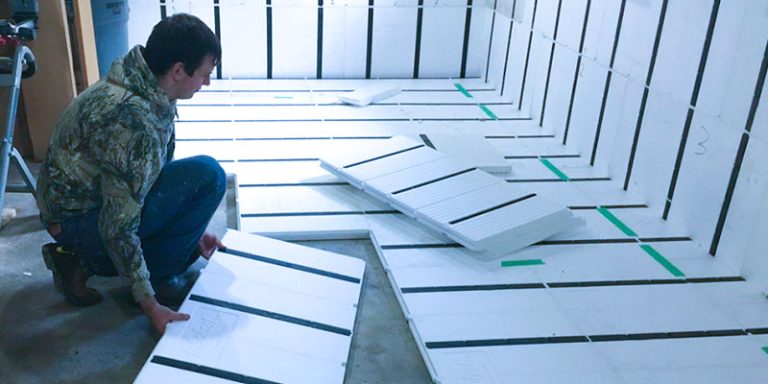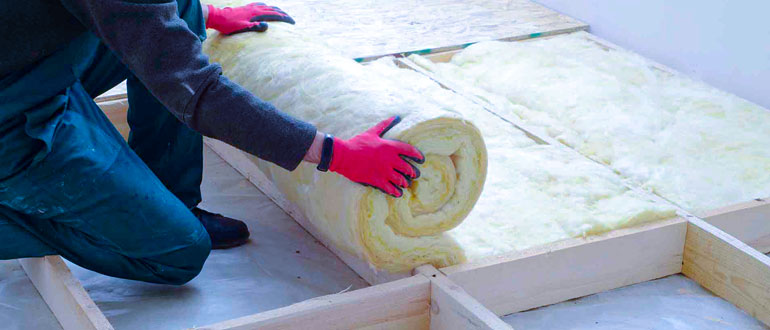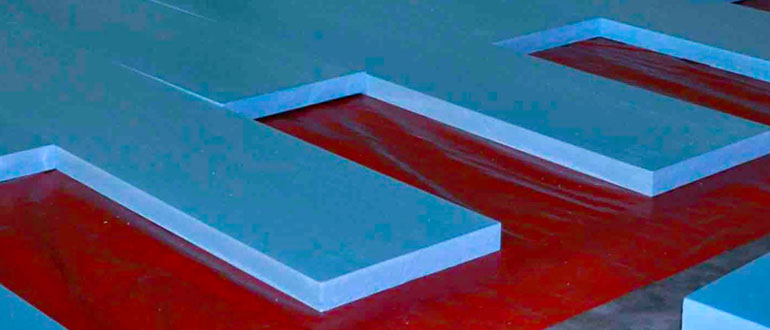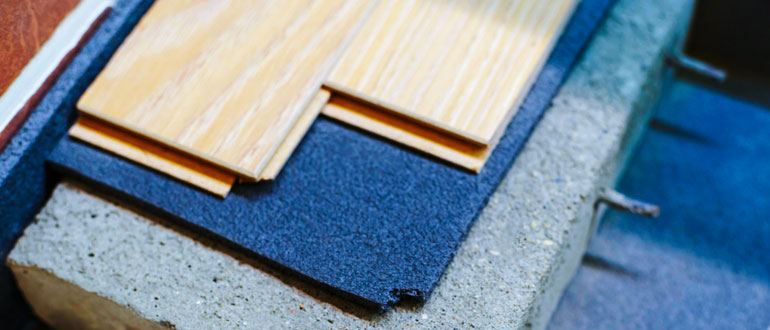If you have a concrete floor in your home or building. You may have noticed that it can become quite cold during the winter months. It is uncomfortable for those who walk on it. Additionally, it can also lead to higher energy bills as your heating system has to work harder to keep the space warm. Don’t worry, let’s explore on how to insulate the concrete floor from cold in the comprehensive guide.
Fortunately, there is a solution: insulating your concrete floor. By insulating your floor, you can keep your space warmer, reduce energy costs, and create a more comfortable living or working environment. In this guide, we will explore the different methods of insulating a concrete floor and provide you with helpful tips and information to help you make the best choice for your needs.
Prepare the area to insulate the concrete floor from cold
Before you begin the process of insulating your concrete floor, it’s important to properly prepare the area to ensure that the insulation is effective and long-lasting. Here are some steps to follow:
- Clear the area: Remove any furniture, rugs, or other items from the space where you will be insulating the floor. This will give you clear access to the concrete surface.
- Clean the surface: Sweep or vacuum the floor to remove any debris, dirt, or dust that may have accumulated. If there are any stains or spills, clean them up using an appropriate cleaner and let the surface dry completely before proceeding.
- Fill any cracks or gaps: Insulation will be less effective if there are gaps or cracks in the concrete. Fill any visible cracks or gaps with an appropriate sealant or filler material.
- Level the surface: If your concrete floor has any uneven areas or bumps. You may want to consider levelling the surface to ensure that the insulation is evenly distributed. This can be done using a levelling compound or self-levelling concrete.
- Install a vapour barrier: Before installing insulation, it’s important to install a vapour barrier to prevent moisture from penetrating the insulation and damaging the concrete. A vapour barrier can install by laying down a sheet of plastic or other moisture-resistant material.
By properly preparing the area before insulating your concrete floor, you can ensure that the insulation is effective and long-lasting. It’s also important to follow the manufacturer’s instructions when installing insulation. To ensure that install correctly and provides the desired level of insulation.
Gather the right tools and supplies to insulate the concrete floor from cold
To insulate a concrete floor from the cold, you will need the right tools and supplies. Here are some of the most common items you will need:
- Insulation material: Several different types of insulation can use to insulate a concrete floor. Including rigid foam board insulation, spray foam insulation, or fibreglass batt insulation. Choose the type of insulation that is best suited to your needs and budget.
- Tape measure: You will need a tape measure to measure the area of your concrete floor and determine how much insulation material you will need.
- Utility knife: A utility knife will be needed to cut the insulation material to size.
- Gloves and safety glasses: When handling insulation material, it’s important to wear gloves and safety glasses to protect your skin and eyes.
- Vapour barrier: As mentioned earlier, a vapour barrier is necessary to prevent moisture from penetrating the insulation and damaging the concrete. You will need to choose the appropriate vapour barrier material based on the type of insulation you are using.
- Adhesive: Depending on the type of insulation you choose; you may need adhesive to secure it to the concrete surface.
- Insulation supports: If you are using fibreglass batt insulation, you will need to use insulation supports to hold the insulation in place.
- Sealing tape: Sealing tape can be used to seal any gaps or seams in the vapor barrier.
Gathering these tools and supplies before you begin the insulation process. You can ensure that you have everything you need to complete the job efficiently and effectively.
The best ways and methods to insulate concrete floors from cold
There are several effective methods for insulating a concrete floor from the cold. Here are some of the most common methods:
- Rigid foam board insulation: Rigid foam board insulation is a popular choice for insulating concrete floors. This type of insulation is easy to install and provides excellent insulation properties. The foam boards are cut to size and glued directly to the concrete floor using an adhesive.
- Spray foam insulation: Spray foam insulation is another effective method for insulating a concrete floor. This type of insulation is applied as a liquid and expands to fill any gaps or cracks in the concrete surface. Once dry, it provides a strong, continuous layer of insulation.
- Fibreglass batt insulation: Fiberglass batt insulation is a more traditional type of insulation that can use to insulate a concrete floor. The insulation is cut to size and placed between the floor joists or sleepers, which are then covered with a vapour barrier and finished flooring.
- Insulating concrete with integral insulation: If you are pouring a new concrete floor, you can also consider using integral insulation. This involves adding insulation materials to the concrete mix before pouring the floor, creating a layer of insulation within the concrete itself.
No matter which insulation method you choose. It’s essential to also install a vapour barrier to prevent moisture from penetrating the insulation and damaging the concrete. You may also want to consider using a radiant heating system. Which can be installed underneath the insulation layer to provide additional warmth and comfort to the space.
DIY guide to insulating concrete floor from cold without professional help
Insulating a concrete floor from the cold can be done as a DIY project, but it will require some planning, preparation, and attention to detail. Here is a step-by-step guide to insulating a concrete floor without professional help:
- Measure the area: Use a tape measure to determine the square footage of the concrete floor you want to insulate. This will help you calculate how much insulation material you will need.
- Choose the insulation material: Depending on your budget and needs, you can choose from rigid foam board insulation, spray foam insulation, or fibreglass batt insulation. Make sure to choose the appropriate insulation material based on the type of floor and the climate in your area.
- Prepare the surface: Before installing the insulation material, make sure the surface of the concrete floor is clean and free of debris. Fill any cracks or gaps in the floor and level the surface if necessary.
- Install the vapour barrier: Lay down a sheet of plastic or other moisture-resistant material over the entire surface of the concrete floor. Secure the vapour barrier in place with tape or other appropriate fasteners.
- Install the insulation material: Cut the insulation material to size using a utility knife and place it on top of the vapour barrier. If you are using fibreglass batt insulation, use insulation supports to hold it in place.
- Seal the seams: Use sealing tape to seal any gaps or seams in the vapour barrier and insulation material. This will help prevent moisture from penetrating the insulation and damaging the concrete.
- Finish the floor: Once the insulation is in place, you can finish the floor with your desired flooring material, such as carpet, tile, or wood.
Common issues to insulating concrete floor from cold
It is a straightforward process while insulating a concrete floor from the cold. There are a few common issues that can arise if proper attention does not apply. Here are some of the most common issues to be aware of when insulating a concrete floor:
- Moisture: Concrete floors are porous and can absorb moisture from the ground or the air. If moisture is allowed to penetrate the insulation layer, it can cause damage to both the insulation and the concrete. To prevent this, it’s important to install a vapour barrier between the concrete and the insulation layer.
- Air leaks: Even small gaps or cracks in the insulation layer can allow cold air to seep into the space. To prevent this, it’s important to carefully seal all seams and gaps in the insulation layer with sealing tape.
- Inadequate insulation: In some cases, the insulation material used may not be sufficient to provide the desired level of insulation. This can result in cold spots or uneven heating in the space. To ensure adequate insulation, make sure to choose an appropriate insulation material and follow the manufacturer’s recommendations for installation.
- Improper installation: Proper installation is crucial for the effectiveness of the insulation layer. Improper installation, such as using the wrong type of adhesive or failing to secure the insulation. The material in place, can compromise the insulation layer and reduce its effectiveness.
- Cost: Depending on the type of insulation material used, the cost of insulating a concrete floor can vary significantly. It’s important to carefully consider your budget and needs when choosing an insulation material and to plan accordingly.
By addressing these common issues and taking the necessary precautions, you can effectively insulate your concrete floor from the cold and enjoy a more comfortable living space.
The most common FAQs
Here are some frequently asked questions (FAQs) regarding insulating a concrete floor from the cold:
Why should I insulate my concrete floor?
A: Insulating a concrete floor can help prevent heat loss through the floor, making your space more comfortable and energy-efficient. It can also help prevent moisture from penetrating the concrete and damaging the structure.
What type of insulation material should I use?
A: There are several types of insulation materials. To choose from, including rigid foam board insulation, spray foam insulation, and fibreglass batt insulation. The type of insulation material you choose will depend on your budget, the climate in your area, and the type of floor you have.
Can I install insulation on an existing concrete floor?
A: Yes, it is possible to install insulation on an existing concrete floor. However, it may require some additional preparation work, such as levelling the surface and filling any cracks or gaps.
Do I need to install a vapour barrier?
A: Yes, it’s important to install a vapour barrier between the concrete floor and the insulation layer. To prevent moisture from penetrating the insulation and damaging the concrete.
Can I install insulation myself, or do I need professional help?
A: Insulating a concrete floor can do as a DIY project, but it will require some planning, preparation, and attention to detail. If you are unsure about your ability to complete the project, it may be best to consult a professional.
Will insulating my concrete floor make my space warmer?
A: Insulating your concrete floor can help prevent heat loss through the floor. It can make your space feel warmer and more comfortable. However, it’s important to also consider other factors, such as the insulation of walls and windows, to ensure maximum energy efficiency.
By understanding these FAQs, you can make an informed decision about whether or not to insulate your concrete floor and how to go about doing it.
conclusion
In brief, Insulating a concrete floor from the cold can help improve the energy efficiency of your home and building. Additionally, Making it more comfortable and cost-effective to heat. By following the right steps, tips and techniques, you can do this properly. You should use appropriate insulation materials and installation techniques. Then, you can effectively insulate your concrete floor and prevent heat loss through the floor.
However, it’s important to be aware of common issues, such as moisture and inadequate insulation. And to take the necessary precautions to prevent them. By doing so, you can enjoy a warmer, more comfortable living space. While reducing your energy bills and minimizing your impact on the environment.





